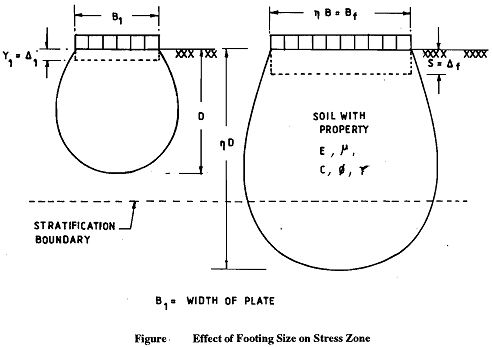Q. Effect of Footing Size on Stress Zone?
The modulus of elasticity of the soil may be determined by plotting stress-strain diagram based on triaxial test or plate load test. In granular soils it is found that E, increases with depth (i.e. sensitive to lateral pressure). The test sample should be taken at a depth B/2 or B beneath the proposed footing to get an average value of E,. The modulus of elasticity of cohesionless (pure sand) material. will not be influenced by moisture content and particle size. However void ratio affects to a considerable extent. E, is a function of depth in granular soil.

The modulus of elasticity determined from plate load test is to be correspondingly modified as
Let A,, = settlement of plate of width B,,
A = settlement of a footing of width B , = nB,,
q = intensity of stress (constant),
D, = depth of influence for plate Be,
nD= depth of influence for footing tlD1 = Bf,
Ep = modulus of elasticity from B,, and
Ef = modulus of elasticity to use for footing B,.
From Figure the settlement of a plate would be proportional to the depth of stress influence B,. Hence by proportioning

But from Mechanics of materials

Terzaghi indicates that for granular soils the following relationship to be true:

or solving for E, by appropriate sub situation

Hence modulus of elasticity of the granular soil can be extrapolated from plate load test. Modulus of elasticity of cohesive soils has been found to be relatively constant with depth. Hence depth correction is not necessary.